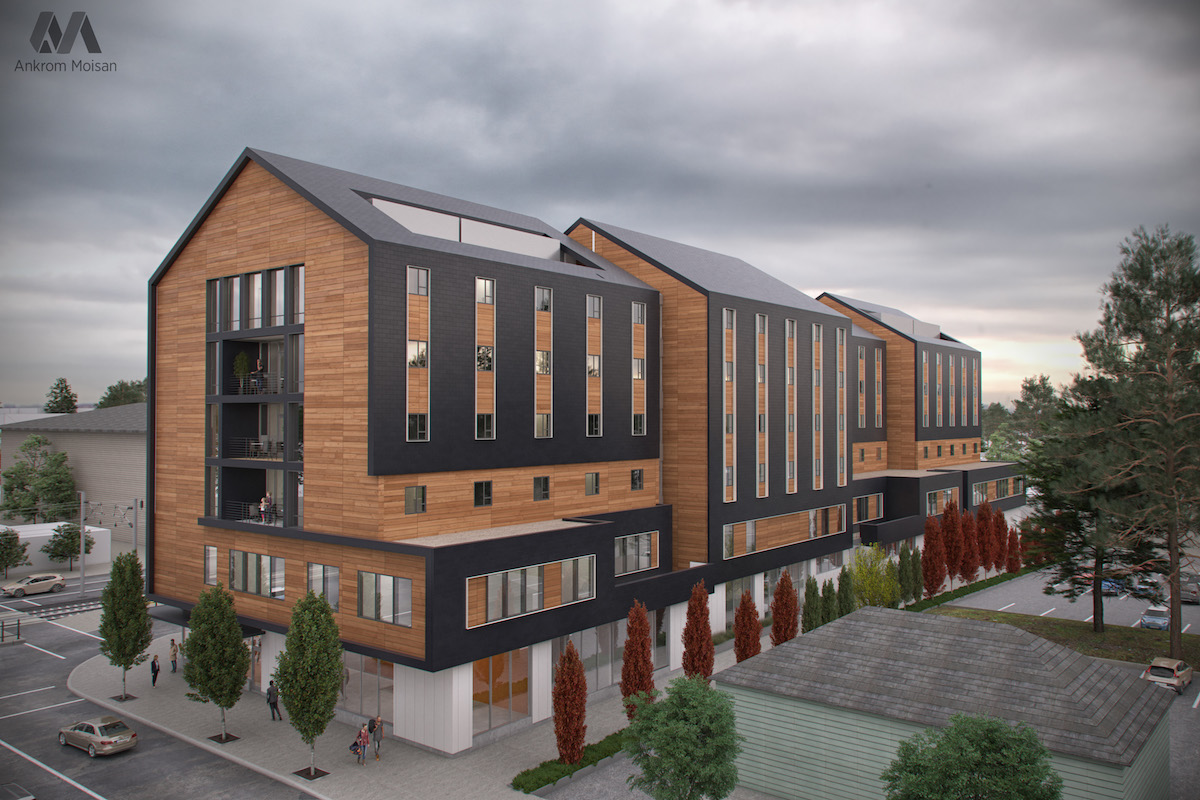
A building permit was issued for Central City Concern’s Blackburn Building
Every week, the Bureau of Development Services publishes lists of Early Assistance applications, Land Use Reviews and Building Permits processed in the previous week. We publish the highlights. This post covers November 13th to November 19th, 2017.
Design Advice has been requested by Carleton Hart Architecture for a project at 1727 NW Hoyt St:
Two new buildings and restoration of a Historic building (Contributing Structure) in Alphabet district.
Early Assistance has been requested by Design Department for a project at 4212 N Interstate Ave:
Current Code – New 4 story mixed use building. 1st floor retail 15 apartments proposed, no parking proposed.
A Pre-Application Conference has been scheduled by GBD Architects to discuss a project at 1120 SE Main St:
The proposal is a 1.5 acre site comprised of an existing two story commercial building to be renovated to be creative office/retail, a new wood framed five story multi-family building with ground floor retail, and a new manufacturing and production building with above with above grade parking. Total development to contain 72 apartments, 66,000 gsf manufacturing and production, and 94 vehicular parking stalls.
A Pre-Application Conference has been scheduled by Case Design Group to discuss a project at 2231 NW Pettygrove St:
Current Code – New 5 story 29 unit apartment building. Purposed development valuation will trigger a Type 3 review.
A project at 4941 NE 14th Pl has been submitted for building permit review by CIDA Architects:
New 3 story, 15 unit apartment building, includes associated sitework
A building permit was issued for a project at 6041 NE Flanders St (previously 6035 NE Flanders St):
Construct 3 story, 4 plex building with 2 tuck under garages, 2 units on lowest level, 2 main floor units with upper levels above, no detached trash area, includes associated site work
A building permit was issued for a project at 7070 N Montana Ave (previously 7032 N Montana Ave):
Construct new 3 story six plex, no parking, detached trash enclosure less than 120sf in area, includes associated site work
A building permit was issued to Studio 3 Architecture for a project at 7210 N Burlington Ave (previously 7220 N Burlington Ave):
New 3-story, 19-unit multifamily apartment structure***deferred submittals: pre-engineered wood floor joists, pre-engineered wood roof joists, built in landscape irrigation (design build)***
A building permit was issued for a project at 123 SE 13th Ave (previously SE 13th and Ankeny):
New 87 unit, 4 story apartment building with roof deck. 5 parking spaces, landscaping and utilities
A building permit was issued for a project at 3618 SE 92nd Ave:
New construction of employee lift dispatch building with dispatch, training, offices, kitchen and two bathrooms; Site Improvements including new vehicle storage area and employee parking area; re-paving private road leading to parking area. Adjacent lift storage building under permit 17-187922-CO.
A building permit was issued to Ankrom Moisan Architects for The Blackburn Building (also known as the Eastside Health Center) at 12121 E Burnside St:
New 6 story mixed use building to consist of medical clinic, mix of transitional housing and mult family residential housing
Tell me again what 1727 NW Hoyt “contributes” to the Historic District?
Ok, I’ll step up and make the case for this one. It contributes two valuable things.
First, it’s a decent example of a nice brick multifamily typology that has served this city well. These buildings usually have about 18 units give or take and on a single lot, contribute an estimated 150 units an acre of residential density on average. Clean up the facade, restore the double hung windows, and I’m sure it will be quite beautiful. Individually, losing one of these buildings is not a big deal, but cumulatively, losing a lot of them strips away a layer of our urban history. These buildings still have a lot of life in them and people seem to like them.
Second, it preserves the plat module and thus the granularity of the block. From an urban design standpoint, a block like this benefits from having a diverse mix of buildings rather than consolidating four lots into a single large building. If you examine the surrounding grain, it’s still mostly 5000 sf lots, and if you can achieve the desired density with multiple buildings that can function autonomously and live their own lifecycles, that’s a good thing.
Because it is the Buck-Prager Building which was saved from demolition. Check this link:
http://www.oregonlive.com/business/index.ssf/2014/12/portland_city_council_rejects.html
Orginally it was the Women’s Hospital of Portland, so it contributes to the history of the Alphabet District.
I really like the Blackburn building, and I cannot overstate how thrilled I am to see pitched roofs beginning to make an appearance on mid-rise residential buildings. They are extremely common in northern Europe, in cities like Copenhagen, where most people live in 5-6 story flat blocks. One thing I really like about them is the symbolic value of the form. I think for many people, the pitched roof carries a signifies of “home” differentiating it from other mid-rise typologies such as office and warehouse. As we transition to an era where more of us live in multifamily buildings, I see a lot of value in “softening” the semiotics of midrise blocks.
Here are a few examples of Danish prototypes:
http://www.gettyimages.com/event/danish-housing-as-biggest-banks-face-law-restricting-mortgage-brokering-479114963?esource=SEO_GIS_CDN_Redirect#danish-national-flag-flies-from-a-flagpole-outside-a-traditional-picture-id478611655
https://a0.muscache.com/im/pictures/34829648/7ed1882a_original.jpg?aki_policy=large
“carries a signifier”
I agree, Jonathan. Now if we can just get more sloped roofs atop commercial buildings. This could another way that architects can help differentiate Portland’s built environment from other American cities.